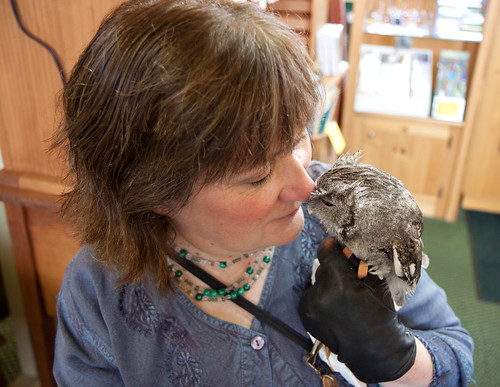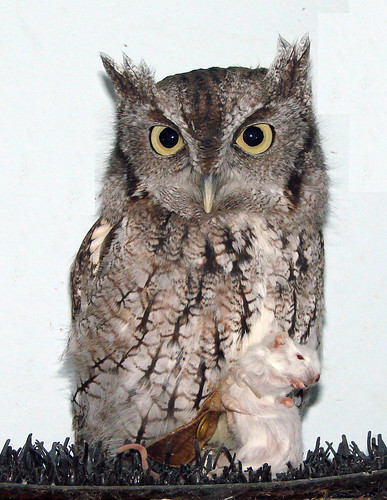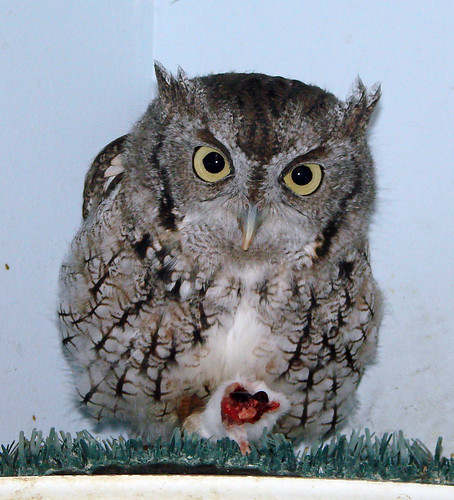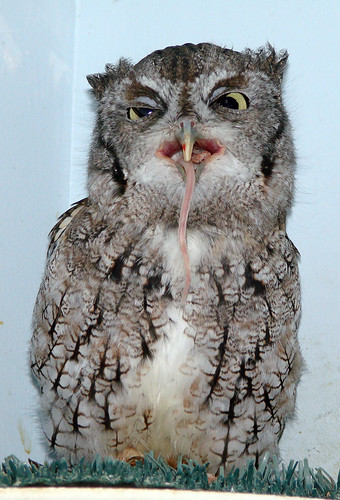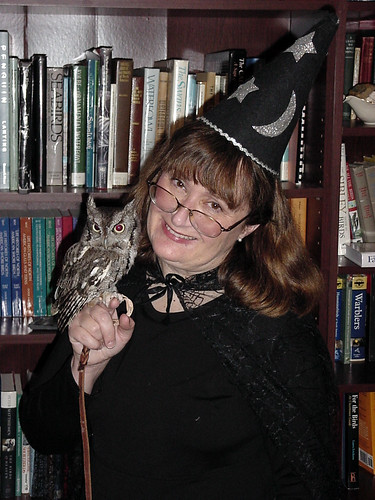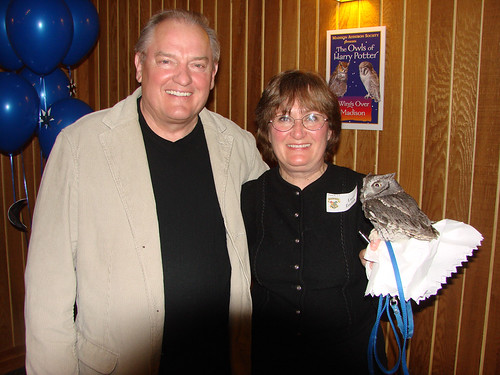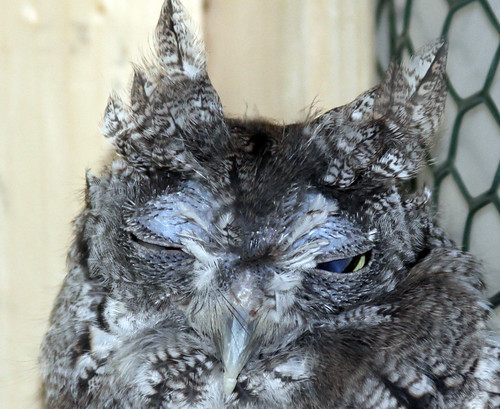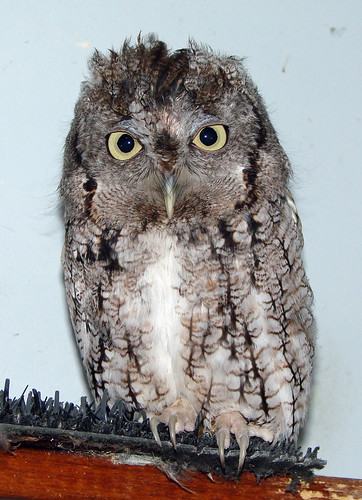Rehabbers seldom feed healthy baby owls anymore—it’s wiser to entrust them to the care of an adult owl of the same species. Owls may be predators, but virtually all adults have a strong urge to nurture and protect baby owls. Unfortunately, this little owl was so weak from both starvation and infections that he required intravenous care for several days, and a liquefied diet for even longer. Meanwhile, rehabbers cared for his skin injuries with salves. So he learned early on that human beings were gentle and kind.
After he was fully healthy and beyond the stage where owlets normally start separating from their families, the clinic tried to release him twice. And twice he landed on people who brought him back to the clinic. The rehabbers knew he was hunting successfully because both times he was returned, he was heavier than he was when they'd released him. After the first time, because they knew he was able to hunt on his own, they tried “aversion therapy.” Now when anyone entered his enclosure, if he didn’t immediately retreat, they’d shoot him with a Super Soaker squirt gun. He quickly learned to flee when people approached, but when they released him again, again he started alighting on people. They realized that the lesson he had learned was simply to avoid people who are carrying a Super Soaker.
Now they were left with two alternatives: they’d have to euthanize him or transfer him to a licensed individual or facility as an education bird. Through several wonderful coincidences, on April 8, 2000, when he was one year old, I happened to be the person he was entrusted to.
Of course, there were immediate complications. Russ had to find and fax my permit to me in Ohio. It was filed under “Eastern Screech-Owl,” but my file drawers are organized in taxonomic rather than alphabetical order, so putting his hands on it was a bit more tricky a task than it maybe should have been. After I received the fax, possession of the little owl was legally transferred to me at about 6 pm the night before I flew home. I brought him back to my hotel room in a small cardboard box—the kind a pet shop would place a purchased guinea pig in.
I figured a plane ride would be a daunting experience for a little owl, so I spent the night trying to earn his trust. Unlike hawks and many other birds, owls spend quite a lot of time allopreening—that is, preening their mate, their young, and their nest mates. I figured my preening him with my fingers would work like a switch, making him realize that I wasn’t dangerous but was a family member. Of course, that switch didn’t work the first time, or the second, and at bedtime, he was still pretty intimidated by me. So I set my alarm clock to wake up in an hour, and tried again. I stroked him and gently drew his facial and nape feathers through my fingers, and then bowed my own head in front of him. He didn’t accept me that first time I woke up, nor an hour later, nor an hour later. But sometime around 2 am, he not only let me stroke and preen him, but he preened some of my hair. By morning, he was also preening my eyebrows. I knew he had accepted me.
Flying with an owl involves some red tape. As soon as he'd faxed my permit, Russ called the airline (I think Northwest) to make sure I could fly with the little guy. They said he would count as my carry-on luggage, so I had to check my bag—back then that was free. But they also said that bringing any animal on board cost $75.
Meanwhile, I needed to have a place for Archimedes at home. After Russ called the airline, he started building a nice, safe flight cage in my home office—he finished it before we got home the next day. He also picked up a few frozen mice at a local pet shop.
My good friend Paula drove me and Archimedes to the Cleveland airport. At the ticket counter I had to pay the $75 to travel with a “companion animal”—the woman at the counter of course wanted to see him—and then we had to go through security. This was before 9-11, so that didn't pose too many difficulties. I did have to send his little carrying-box through the luggage x-ray, but they let me put him, in his jesses, on my hand to just go through the metal detector. (He had wings, so you’d think they’d see right off that he wasn’t armed.) Going through security with an owl on one’s hand is one of the rare things that draws attention to a shy middle-aged woman, but he and I both survived the stares and questions and joking. During the flight, I picked up the box a few times and reached in to stroke his head, and he seemed reasonably comfortable with that. I was sitting next to a young boy, and let him peek at Archimedes each time—the boy was utterly charmed.
My kids instantly fell in love with him. He was the same size as a popular toy in 2000, the “Furby,” but my son Joe, a high school senior at the time, insisted on naming him Archimedes for Merlin’s avian companion in the Disney movie The Sword in the Stone, based on the same characters in T.H. White’s The Once and Future King.
I put a Wood Duck box in the new flight cage so Archimedes could hide out if he chose. He did roost in there for a while that first day, and on and off for the next couple of weeks, but as he felt increasingly secure within that first month he stopped using it entirely. I kept it in the cage for the next 17 years, but he never again went into it.
I did an online search for a place where I could get frozen mice in larger quantities, at a lower price, than at a pet shop. I usually bought 100 at a time, so an order would last for more than three months. Over the years, I found it hard enough dealing with already dead rodents—it would have been too traumatizing for me, to say nothing of the mice, if I had to get live ones. One of my friends said it was the best deal to get experimental mice from medical research facilities. I tried it once, but threw them out because the first one I thawed out smelled horrible. The next place I tried was ideal—the mice looked perfectly healthy and happy, well except for being dead. That place guaranteed that the mice had been fed organic food and were humanely killed. Sadly, that company went out of business several years ago.
After that, mice from the first place I tried looked all scratched up and scrawny, which was bad both in the sense that the poor little rodents looked like they’d led miserable lives and in the sense that they didn’t look like their meat could be very healthy. The next place I found was pretty good, though I was never as satisfied as I'd been with the organic mouse farm.
The mice from that organic mouse farm came packaged on styrofoam trays exactly like the ones you'd buy grocery store chickens on. The ones I'd been getting more recently were loosely packaged in plastic bags. Every night I'd take one out and it would be suitably thawed about an hour later. Russ often used the microwave, but hearing the tiny popping sounds if they were in a second too long was enough to keep me from even trying that.
When I'd put the mouse in the cage, Archimedes usually swooped right in. He didn't like me watching him eat, especially holding a camera, so I took one series of photos of him eating and left it at that. He usually bit off and swallowed the head and upper torso first, in one quick bite.
Then he'd swallow the lower half of the mouse's body. But it took a minute or so for the tail to work its way down the hatch—kids often commented that the tail going down looked like a strand of spaghetti.
I didn't keep careful track of how long it took him to produce a pellet, but he'd spit one out each day, at least sometimes about 6 or 8 hours after eating. One time when I was showing him to a group of little girls in a science study group, one girl just happened to have her hand near him when he spit the pellet right into it. They were moist but not wet when they came out, and had no odor whatsoever. On the other hand, his droppings were fairly smelly. Screech owls, like the Common Nighthawks I specialized in when I was rehabbing, have active caeca—blind offshoots of the large intestines where some bacterial digestion takes place, and the waste produced by the anaerobic bacteria in there has a strong, bitter odor. Most of the year I kept his cage clean, but Russ always did it for me when Archimedes was molting because I was allergic to his feathers. At the peak of molt, his cage could look like there had been a pillow fight in there.
People often referred to Archimedes as a "pet," but he simply was not. He was a licensed education bird, and I was not his owner, but the person licensed to “possess” him for educational programs, and legally responsible for his care.
My kids’ response to him—they thought it was cosmically cool that their mother was the only person they knew of anywhere who was allowed to have an owl—was sweet and gratifying, but also a warning to me. They naturally wanted to show off Archimedes to their friends, but Archimedes deserved to have his personal space respected. So in what seemed like a fair compromise, I’d take Archimedes out of his cage and put on his jesses, as we did for all educational programs, when the kids wanted to show him to their friends. My kids were always allowed in my office, and could look at him whenever they wanted—they often fed him when I was out of town without him—but they understood that he had a right to not be gawked at by strangers while he was in his enclosure.
As cool as it was for me to be able to bring such a charismatic little guy to my speaking engagements, I was honor-bound to validate Archimedes’ trust in me. From the moment I took him out of his carrier on his jesses, I always held him close to my body. I cued in on any sign of stress, such as his turning away from people. If he seemed distressed at all, I’d put him back in his carrier or take him to a quiet place to give him a break.
I was already scheduled to do a program at a school the first week I had Archimedes, so I brought him along. I was thinking I’d need to ease him into the routine with very short appearances at first, but he was great—relaxed and attentive. He quickly settled into our routine. I’d put on his jesses and leash, and put him into a cat carrier for the ride in the car. On our way to the classroom or gymnasium or wherever we were going to speak, I’d occasionally allow a person or two to peek in the carrier, but asked them to hold their face back a distance so he didn’t feel intimidated. I never took him out of the carrier until the room was quiet—it’s amazingly easy to quiet down kids, from preschool through high school, when the payoff is to see an owl.
Only once did I ever have to walk out of a speaking engagement with him—that was at an all-school assembly at a charter school in Duluth. At that one school, the moment I brought him out of the carrier, kids started squealing and laughing and talking loud and standing on their seats and even approaching us, and the teachers could not settle them down. One of the teachers even started literally screaming to shut them up. I put Archimedes back in his carrier and walked out with him.
For the first several years, when I’d arrive somewhere before a program, I’d discreetly call one or two people, often children, and let them stroke Archimedes’s forehead as I’d done myself that first night with him, giving him a clear signal that this person was a trustworthy part of our “family.” That always seemed to comfort him and settle him down before a program. Sometimes after we were done, if the kids had been really good and he was still very relaxed, I’d let the kids stroke him one by one as they left. It gave the kids a lasting memory, and never distressed Archimedes, but I had to stop that when the U.S. Fish and Wildlife Service started prohibiting any physical contact between the public and an education bird.
I was very careful never to exploit Archimedes by promoting myself for “having an owl.” I was invited to bring him to Harry Potter book release parties, and decided that the opportunity to teach a large number of children how real owls are different from those in J.K. Rowling’s magical universe was a golden opportunity. In that context I dressed as a witch, “Professor McGonagowl,” to walk about during those big book release events.
The big crowds on those nights were daunting, but I’d keep him close, putting a finger to my lips if people were being noisy around him, and the kids and parents were wonderfully cooperative and respectful. Archimedes was in his prime when the books came out. We did our first one at Duluth’s Barnes and Noble in 2000 with the release of Harry Potter and the Goblet of Fire, when Archimedes was one year old. After that, we did them with the independent Northern Lights bookstore at the Duluth Depot—they decorated one old locomotive as “the Hogwarts Express.” Archimedes was 8 years old at the final party, when Harry Potter and the Deathly Hallows was released in 2007.
I developed an educational webpage, “The Owls of Harry Potter,” with a photo of Archimedes and me as Professor McGonagowl on top. (More than half a million people have visited the page!) But I never promoted myself for other speaking gigs in that role—that seemed to put self-promotion over Archimedes’ needs. We did do some programs specifically about the Owls of Harry Potter, but much more often about owls in general. I never really tallied up a total, but he's appeared before several thousand people over the years.
Most of the programs I brought him to were local or at least no farther than the Twin Cities, but we did go further afield for some special events. I brought him to Chicago when my high school put me on its "Wall of Fame" and I was asked to give a talk at a an all-school assembly there.
I also gave a talk about owls at a Midwest Birding Symposium when it was held in Davenport, Iowa, and once at a school assembly in Stockton, Illinois, where one of my closest friends was working.
Archimedes didn’t seem to mind long drives, but never did like overnight engagements—at the end of a gig, he wanted to unwind in the familiar territory of home. I think the last program we did involving an overnight was in Madison, Wisconsin, in March 2007. I was the speaker at Madison Audubon’s spring banquet, talking about owls. Wisconsin Public Radio’s Larry Meiller was to be the emcee for the evening, and invited me and Archimedes to be his guests on The Larry Meiller Show that day—it was the only time Larry ever had an owl in the studio, and he said Archimedes was the quietest, calmest animal visitor ever on the program. (You can listen to that program here.) The studio was only a couple of blocks from St. James School, where I had been a teacher back in the 70s, so we also headed to the school for an assembly after the radio gig. That was the heaviest single day speaking schedule Archimedes was ever subjected to, but he held up just fine during the events—it was only after we were all done, when he expected to go home but instead we stayed the night at a friend’s house in Madison, that he seemed distressed. I was up much of the night with him because he wasn't comfortable in the strange surroundings. He got through it all just fine, but that was when I decided no more overnights for him.
Archimedes has also been to KUMD, KAXE, and WXPR over the years.
| Archimedes at WXPR |
Lots of people thought it was exceptionally cool for me to live with an owl, but I always felt a heavy responsibility to keep people from romanticizing that, especially in the era of Harry Potter—for years, as the books and movies came out, I’d get at least a couple of emails a week asking how one could get a pet owl. It’s very rare nowadays for any individual to get an education permit; most are given to educational organizations, and few individuals anymore can legally keep their birds at home with them. That’s why I didn’t talk about Archimedes as much as I’d have liked.
Having him in my office with me was such a sacred privilege. When I was writing late at night, he’d often start calling, and I’d call back. Some of our interchanges lasted a half hour or more. And sometimes, when he was bored, lonely, or something else—he kept his emotions to himself—he’d call when I wasn’t in my office, and I’d answer from somewhere else in the house. That could go on for a while, too.
About half the time if I called to him from somewhere in the house, he’d answer back, but he wasn’t like my dog Pip, obeying my commands. In that, as well as many other respects, he was more like a cat. Like a cat, Archimedes slept whenever he felt like it, day or night.
There’s a joke that we humans are never a cat’s owner—they see us as staff. I don’t think Archimedes saw me as staff—cats are domesticated animals, while owls and other wild birds never have or expect to have a caretaker. I think for Archimedes, I was more like his mate. Screech-Owls usually remain with their mate year-round, even though they’re only interested in sex during a very short time in early spring.
The mated birds in a pair sometimes roost together, sometimes not. During hunting, which is a solitary occupation, they often remain in contact by calling. I think Archimedes viewed me as screech-owls view their mate most of the year. I clearly didn’t do any of the things that would have made him expect more from our relationship in spring—he called more in late winter and spring, as wild owls would, but never seemed particularly interested in anything beyond that. For most birds, mating puts them in such a vulnerable position that they have no interest in it until after a long period of escalating interactions between courting birds that prime them, hormonally and behaviorally, to synchronize their mating impulses.
Owls don't necessarily get lonely for their own kind, and certainly can have problems when forced to live with another bird not of their choosing. Several years ago, the Lake Superior Zoo had to separate their male and female screech owls because the female kept hurting the male. We may romanticize the idea of providing birds with a partner, but like us, they like to have some say in the matter. And until they’ve fully accepted a mate, they prefer to be by themselves.
So I’m pretty certain that Archimedes never seriously minded not having a mate, even as I went through the last 17 ½ years feeling sad that he could never have a natural life in the wild with his own kind. I did my very best to give him as good a life in captivity as I could. To give him exercise, I sometimes ran him around the block—I’d hook his jesses to a leash and hold that in one hand as he sat on my wrist while I carried him outside. Almost as soon as I'd start running, he’d take off and fly above me, landing every now and then and taking off again. I was never a fast runner, but he didn't seem to mind. We always did this at night—I didn't want people in the neighborhood to think of him as a pet, after all. We didn't go running very often in his final years, as much because I’ve been slowing down as because he was. But I did often let him fly loose in my home office while I was working. I had to be there with him—one time he somehow managed to fall behind a seven-foot-high book case, and if I hadn't been there to see what happened, it would have been tricky to find him. He didn't make a sound as he waited to be rescued. When he was loose, he spent most of the time sitting on the back of my chair or on my shoulder. That gave me a warm feeling that I must be doing something right.
Every now and then, I hear from people who think it’s obscene for any wild bird or mammal to be kept in captivity—that it is far kinder to euthanize those that can’t be rehabbed and released than to relegate them to a tragic life in captivity. I think that's arrogant, and doesn't take into account the truth that birds are sentient beings who deserve to have some say in their fate. When I was rehabbing, it was easy to see how different species adapted to temporary captivity. Some, especially ravens, chickadees, waxwings, nighthawks, and warblers, adapted quickly, interested in finding out how things worked in this new life. Not one seemed the least bit reluctant to leave when released, but until that point, they adjusted their expectations as they had to. A few species, especially adult robins, did not adjust well at all, seeming stressed no matter what. If I simply entered the room, a robin would instantly and frantically try to flee, so I had to be especially careful in housing them to protect them from reinjuring themselves. It would have felt unethical for me to keep a robin with a low probability of quick release because they were all so freaked out by even momentary captivity.
But what to do for Archimedes seemed rather straightforward ethically, from the start when he needed to be rescued through when it became apparent that he couldn't be released because he was imprinted. The Ohio children and their mother could hardly leave a baby bird to die in their backyard without at least trying to help. The rehabbers could hardly refuse to treat him when treatment was so straightforward and likely to restore him to health. Once he’d passed the dangerous stage, every step was made to restore him to the wild, such as keeping him in an enclosure with other screech owls to socialize him and then trying to teach him that people would squirt him. And so when it became clear that he was too imprinted, his bond with humans too strong, it made no sense that a human could arrogantly decide for him that the only ethical option was to extinguish his life. His choice, as a sentient being, was to associate with people. As long as he could be placed with a legally licensed person or organization committed to making his life as rich as possible while using him to teach people about owls and important conservation issues, the ethics seem crystal clear.
When I first took possession of Archimedes, he wore leather “bracelets” with grommets, making it quick and easy to put jesses through the large holes. But after a few years, he started getting irritated with them, and when he'd nibble at them, they'd rub against his legs. Finally, I took them off. That meant I had to put his jesses on the old fashioned way, tied in a complicated knot which was very tricky for me to learn. He was surprisingly cooperative virtually every time I put them on, especially considering how clumsy I was about it at first, but a few times, when I had to get him ready for programs two or three days in a row, he objected. When he was most upset with me, he had a tiny little vocalization—a soft “pdddt” sound that I never recorded.
Russ was the first to hear that irritated little swear word, when Archimedes got sick while I was in Ithaca. Russ had to give him medicine once a day, and Archimedes did not approve. I didn't start hearing the sound until, as he was getting older, he started getting more irritable about doing programs too frequently. At first he'd complain only when I was taking him out for a program the third day in a row, but eventually he started making the sound if I took him out the day after he'd done one.
To keep him healthy and his plumage and feet kept in good condition, I needed to make his cage safe. Instead of bars or even wooden dowels, we used plastic mesh for the walls. Marge Gibson gave me some sturdy astroturf—the kind found on doormats—to cover all the perches to protect his feet from developing pressure sores or bumblefoot. When Russ built the new cage in Ithaca, I had trouble finding astroturf at first, and settled for a cheap substitute. One day I got back from work to find him entangled in it. He’d apparently been toying with it and the tip of his bill and one of his claws got caught in a tight plastic loop. Fortunately, I got home in time to rescue him. I ran out that night and found the right product for his perches.
Except for the time he got sick while I was gone, he was extremely healthy. One veterinarian even used him as a prime example to show bird caretakers what healthy bird-of-prey feet look like. But in recent years he seemed increasingly fragile in summer while he was molting. It was a hard time for me, too—I’m allergic to bird feathers, so whenever he was molting, I felt like my head was going to explode. But we muddled through. Molting makes birds itchy, and he seemed especially uncomfortable when new eyelid feathers were growing in. He always looked a little ridiculous when his head feathers were growing in, but that never lasted long.
His usual vocalizations were the typical screech owl whinny and trill, given at what seemed to me to be a fairly low volume, just loud enough that I could barely hear him without my hearing aids from downstairs. I often wondered if wild screech owls modulate their volume to be heard over longer distances as needed to communicate with their mate. Last fall, an hour or so after the Cubs won the World Series, a Boreal Owl started calling from a neighbor's yard, and Archimedes called back, his voice louder than usual.
Russ, my kids, and some of our friends have heard Archimedes call, but only from outside my office where Archimedes could not see them. Only one person other than me has ever watched him making the trill or whinny. My birding friend Erik Bruhnke sometimes stays with us when he's spending time in Duluth, and this summer, when my daughter was also visiting and using the guest room, we put Erik in my office. He set up his computer on my desk near Archimedes's cage. Erik's quiet demeanor and working habits similar to mine seemed to put Archimedes at ease, and soon he was calling away even with Erik right there.
Erik left in early July, and I left for Costa Rica on July 14. I didn't get home until August 4. Russ said Archimedes had done fine the whole time I was gone. I could tell he missed me—when I got home he called more often than usual, seeming to want me to respond, and if I called from anywhere in the house, he'd answer instantly. But he seemed sort of sluggish when I fed him in the morning on August 12. I spent most of the morning in my office, and he called a couple of times, but didn't seem quite normal. I went into his cage a couple of times and preened his face, and he leaned into it like always, but his feathers seemed more fluffed than usual. I figured his molt was starting, so he was probably feeling a little off. I went downstairs for a little while at lunch time, and when I came back upstairs, he had toppled off his perch onto the floor, dead.
I have lost a lot of animals over the years, and a lot of family members and some friends. But never before have I lost anyone I'd lived with for over 17 years. The rhythm of my days has beat in time with his for so long—during the years when I never missed The Daily Show and then The Colbert Report, I'd take out a mouse to thaw each evening before Jon Stewart's monologue, and bring it up to Archimedes the moment I turned the TV off. When I woke each morning, before I did anything else I'd check on him, and always said goodnight before I headed to bed. And while I spent hour after hour at my desk, writing away or processing photos or mixing radio programs, there he'd be, quietly observing, making little whinnying comments, splashing away with his daily bath. My office feels empty and silent now.
People often ask me how long screech owls live. I usually answer that their lifespan is about the same as a dog's or cat's. The oldest wild Eastern Screech-Owl on record at the US Geological Survey’s Bird Banding Lab lived 14 ½ years, but most wild ones have much shorter lives. I’ve not been able to find records of longer-lived ones in captivity. Several zoo websites give the maximum lifespan in captivity as 20, but I can't find any actual records of individuals, or any zoo sites that give the ages of their birds.
I so wanted to give Archimedes as long a life, and as good a life, as I possibly could. I've interpreted some of his confiding ways, like how he'd lean in and close his eyes when I stroked him, as an indication that he was comfortable with me, but there was never a way of asking him what might have made him happier, or what he really wanted out of this life. He gave me so very much of real value in these 17 years he lived with me. It feels so sad to realize that I'll never know if I gave him anything of value at all.
I like to imagine him free now, flying under the moon, or alighting on a massive limb of a big old elm, or peeking out of a Pileated Woodpecker hole in an aspen, or whinnying under the stars somewhere out there in the universe. I like to imagine that he's shaken off his obligation to teach people things they should already understand about the ways of owls and the value of nature—shaken it off the way he'd shake out his feathers after preening, a spray of feather dust forming a sparkling halo around him.
One of the loveliest chapters of my life has ended.
